Lawn tractors and zero-turn landscaping machines can spare you from spending most of your Saturdays hunched behind a lawn mower. They both offer the mowing power, wide decks, and fast operation required to manage expansive yards. However, each has pros and cons.
What are they? Continue reading to find out, zero turn vs lawn tractor!
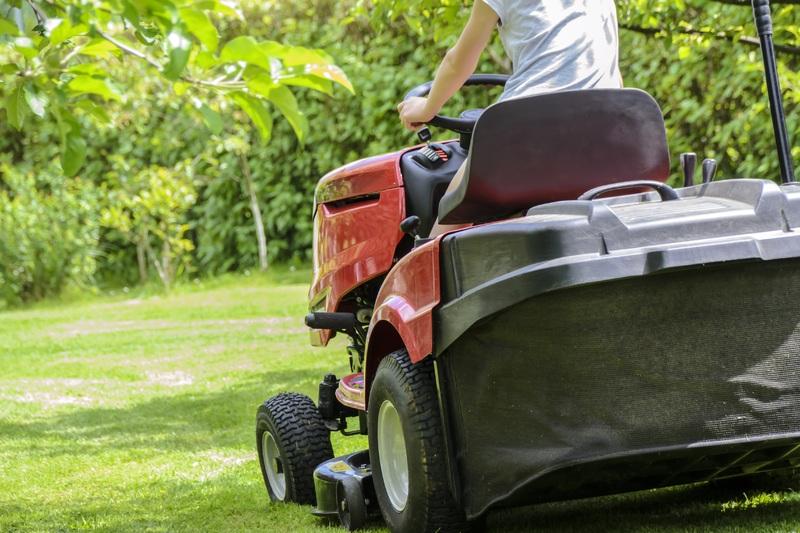
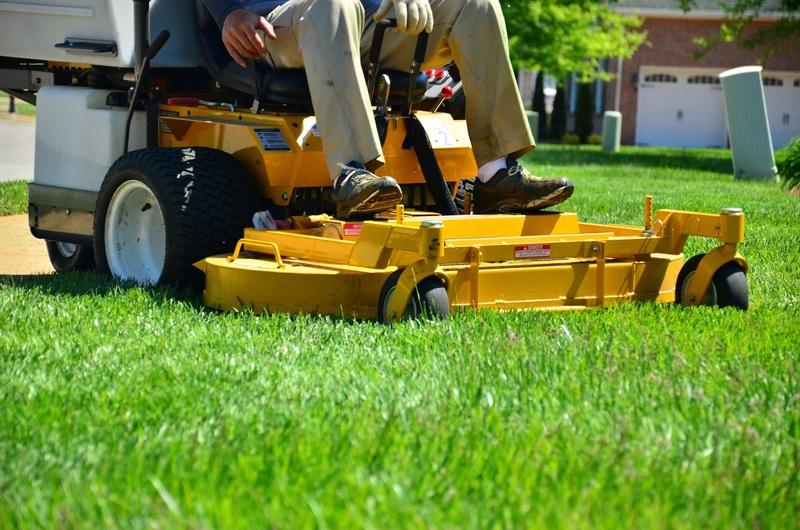
Left – Lawn tractors have a front-mounted engine and a steering wheel for easy operation.
Right – A zero-turn mower has its mowing deck in front of the machine rather than underneath it.
Choosing the correct mower for a large property can be difficult. There are a number of factors to consider when deciding which mowing method is best for your property.
Some lawns may be large, expansive, and steep, while others may be tiny and compact with many trees and bushes, necessitating careful grass trimming.
Of the many mower types available, lawn tractors and zero-turn mowers are popular for expansive lawns. Lawn tractors are best suited for large and extensive yards that are steep or have a lot of hills.
They offer exceptional power and feature a steering wheel for easy maneuvering. In contrast, zero-turn mowers are best suited for lawns with many features and obstacles, such as trees and shrubs. They offer precision and feature a dual-hydrostatic transmission that allows a tight turning radius.
In this article, we will discuss the differences between different mower types, their distinguishing features, and the types of properties they are best suited for.
Lawn Tractor Vs. Zero Turn Mower | Price
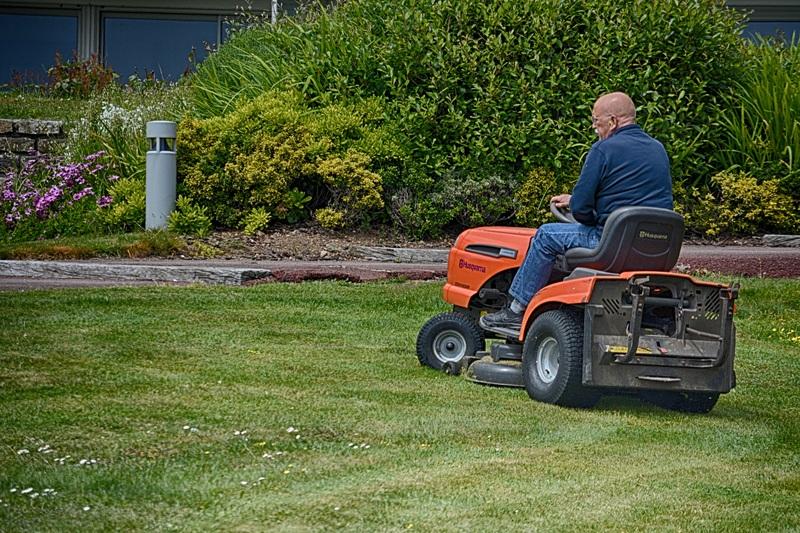
Between lawn tractors and zero-turn mowers, lawn tractors are usually cheaper.
Both lawn tractors and zero-turn mowers are atop the price charts when it comes to mowing machines for home and commercial lawns.
Lawn tractors, however, are the more wallet-friendly option, and they will more than pay for themselves. They can also be used to haul spreaders, carts, sprayers, and other yard equipment.
A lawn tractor could be a worthwhile investment when purchased by the right person. The basic unit costs roughly $1,200, but you will need to spend more if you want a bagging kit, a trailer, or a sprayer.
Whereas the price of a zero-turn mower can range anywhere from roughly $2,500 to well over $5,000, and in some instances, you’ll need to purchase a bagging kit and other lawn equipment separately.
If your property covers several acres and includes a diverse selection of trees and flowers that you need to mow around, investing in a zero-turn model may be well worth the money because of the amount of time it saves.
Related: How To Locate and Clean The Carburetor On A Lawn Mower? | A Beginners Guide
Lawn Tractor Vs. Zero Turn Mower | Speed
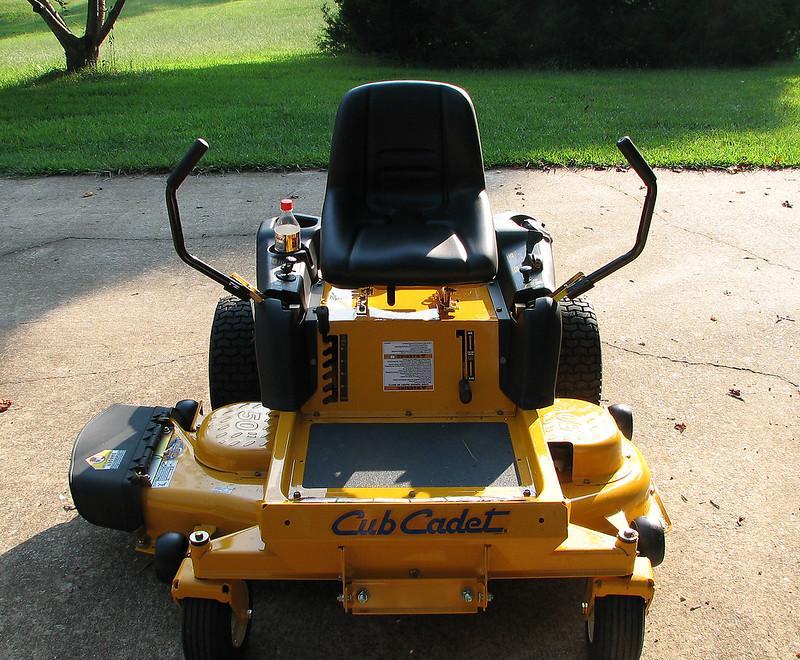
When it comes to speed, zero-turn lawn mowers are usually quicker than lawn tractors.
Before we discuss how quickly lawn tractors and zero-turn mowers mow, it is essential to note that the quality of the cut gets worse the faster you mow, regardless of the type of mower you are using.
Even if you have a fast-moving lawn mower, the highest speeds are reserved for moving to another area of the yard rather than cutting the grass.
Nevertheless, zero-turn mowers provide clean cuts at speeds as low as 5 miles per hour (mph), and they are capable of reaching speeds above ten mph.
In comparison, lawn tractors have a mowing speed of approximately 4 miles per hour and a top speed of approximately 7 miles per hour.
However, lawn tractors may be able to retain their traction and speed better in some conditions, such as on sloped or hilly terrain.
Therefore in some conditions, lawn mowers might be able to cut the grass faster than zero-turn mowers despite their low speed.
Lawn Tractor Vs. Zero Turn Mower | Deck Size
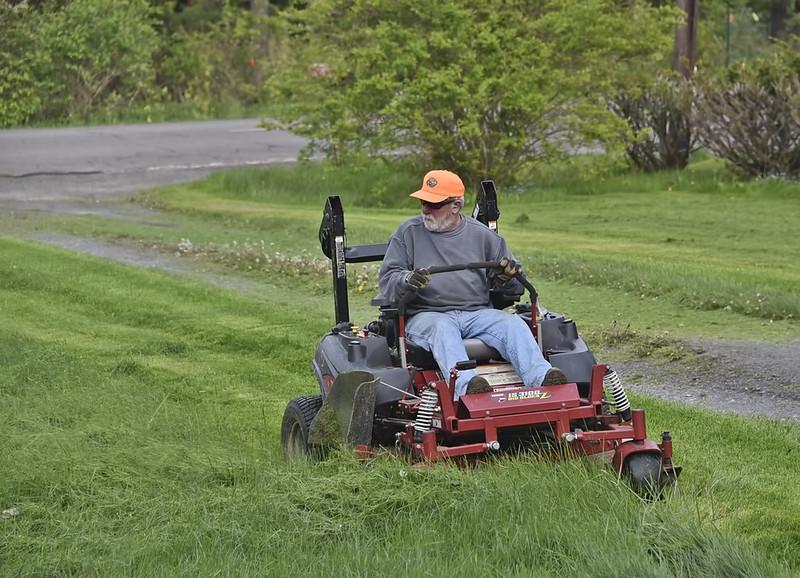
The deck size on zero-turn mowers is usually larger than on lawn tractors.
When selecting the right deck size for your mower (and the mower or tractor that delivers it), it is crucial to take into account not only the dimensions of your lawn but also the size of the spaces that will be the most challenging for you to mow in between or around.
You will need a narrow deck if you want to keep close quarters between trees or flower beds. If, however, you have a level yard that is two or three acres in size and is free of obstructions, you should select the machine with the broadest deck you can afford.
The broader the deck, the fewer passes the mower will take to cover the entire lawn, allowing you to complete the mowing of your entire property in less time.
Lawn tractors typically have cutting decks between 42 and 54 inches, but zero-turn mowers can have cutting surfaces measuring anywhere from 42 to more than 60 inches.
Lawn Tractor Vs. Zero-Turn Mower | Strengths
There are several things to consider before deciding which kind of mower would be ideal for your yard. For instance, the dimensions of your yard, its slope, and the landscaping will all have an impact.
So, before deciding, you should become familiar with the most significant distinctions and strengths of lawn tractors and zero-turn mowers.
Lawn Tractors: Versatility & Power
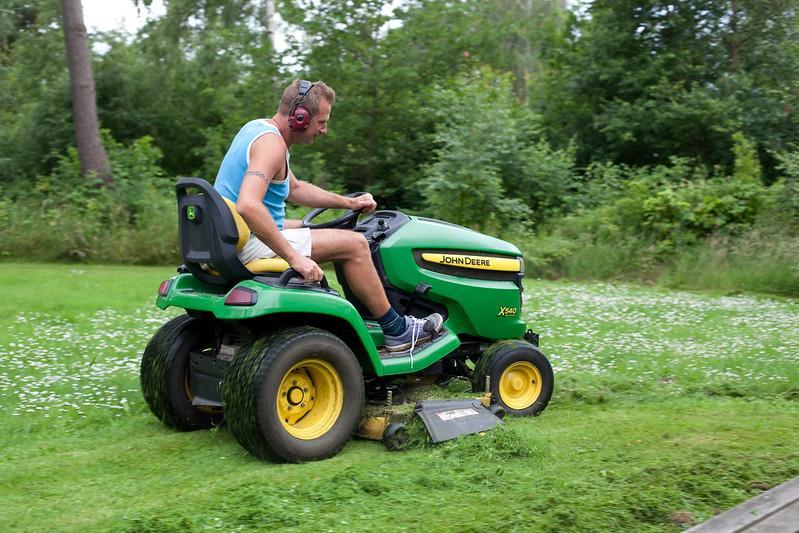
Thanks to the front-wheel drive, lawn tractors can easily inch up slopes and hills.
It’s hard to overstate the versatility of lawn tractors. They are frequently praised for attachments and their ability to climb hills and slopes. Mowing, transporting seeds, pulling trailers, and seeding can all be accomplished using a riding mower.
Lawn tractors are ideal for homeowners with acre-sized yards or larger. Tractors and riding mowers, which look like tiny go-karts, use a classic steering wheel. These mowers are not difficult to learn how to use, and they have a very substantial cutting power.
Depending on the width of the deck, you can have a lot of grass chopped in one go. However, the power and adaptability that lawn tractors offer come at the expense of their lack of precision.
Since riding lawn mowers have a larger turn radius than zero-turn lawn mowers, each time you pass over an area of grass with the riding mower, you will remove more of the grass than you would with the zero turn mower.
This will require a few additional passes to cover the entire lawn, as well as some additional trimming in tight corners and around any obstructions.
Zero-Turn Mowers: Performance & Precision
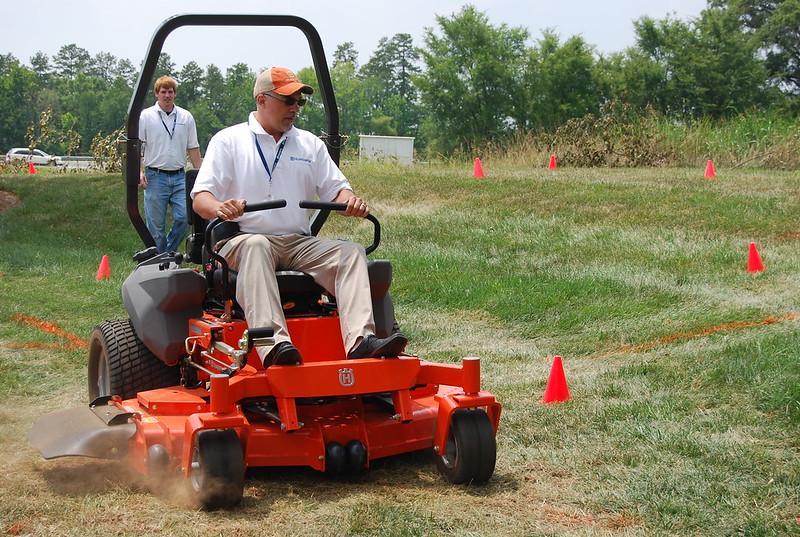
Zero-turn mowers have dual-hydrostatic transmissions contributing to their speed and tight turning radius.
Mowing around bends, corners, and obstacles is simple with zero-turn mowers. They are also quicker than lawn tractors, with a top speed of approximately 10 to 12 miles per hour.
Even if speed is desirable, more precise cuts should be made at a lower speed. Zero-turn mowers are both efficient and precise, making them the ideal choice for lawns featuring a variety of landscape features (flower beds, bushes, etc.).
The name of these mowers comes from the fact that they can turn on a dime and have a turning radius that is nearly zero degrees.
They are equipped with dual-hydrostatic gearboxes, each of which may be controlled via a pair of levers on either side of the seat.
However, zero-turn mowers are not as effective when dealing with elevation and adaptability.
In addition, zero-turn mowers are not often designed to accommodate attachments; even when they are, they cannot handle anything too large.
Lawn Tractor Vs. Zero-Turn Mower | Pros & Cons
You might be wondering if it would be preferable to invest in a tractor mower or a zero-turn mower as the price of powerful mowers has become cheaper in recent years.
To assist you in making a decision, here is a list of their benefits and drawbacks.
| Mower Type | Pros | Cons |
| Zero-Turn | Does not leave any uncut areas. Ideal for lawns that are kept in good condition and are frequently mowed. It is simple to reverse. It is suitable for lawns that contain flowerbeds, trees, or rocks. Quicker than conventional lawn mowers. Simple to navigate around obstacles and areas with limited space. | In tiny yards, a large zero-turn mower deck may be problematic. It has two lever handles, which might be challenging for novice users to master. Not the best tool for yards with slopes. |
| Lawn Tractor | It is controlled with the use of a steering wheel, much like an automobile. Excellent for attaching trailers and other lawn equipment to the back. Excellent for sloped and rugged terrain. Simple in terms of its operation. | Due to its large turn radius, some areas of uncut grass may be left behind. It isn’t easy to use on lawns scattered with flowerbeds, trees, or rocks. Mowing the lawn takes a longer time. |
Related: How To Fix Lawn Mower Sputtering: Common Reasons & Easy Fixes!
Lawn Tractor Vs. Zero-Turn Mower | Ease Of Use
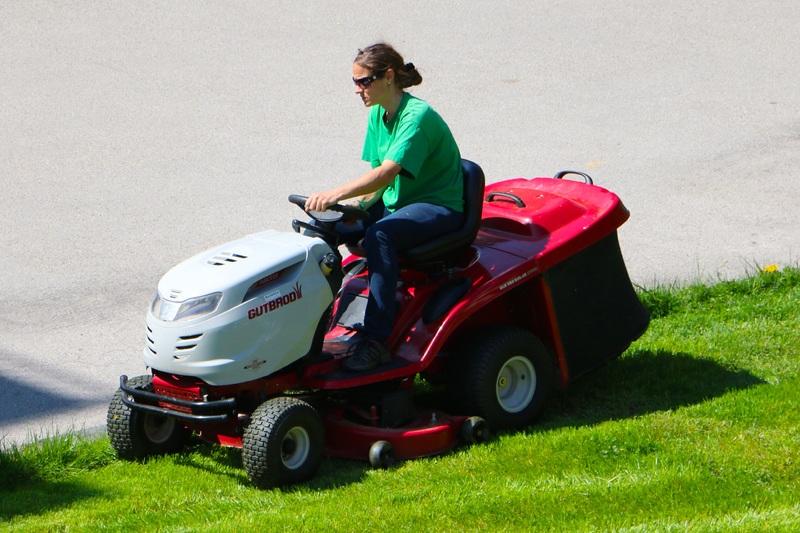
Compared to zero-turn mowers, lawn tractors are easy to use and operate.
One of the most significant differences between a zero-turn mower and a lawn tractor is the ease of use. Let’s talk about it in a bit more detail!
Using A Lawn Tractor Feels Natural!
Those who have prior experience behind the wheel of a car will have no trouble learning how to operate a lawn tractor to cut the grass.
It is pretty easy to understand, and you will have the consistent impression that you are in command at all times.
In other words, there is no need for you to be concerned about adjusting or learning how to use a lawn tractor.
Tractors are designed to be operated in the same manner as automobiles, and they come equipped with a steering wheel and a gas pedal.
Zero-Turn Mowers Are Tricker
Learning how to use a zero-turn lawn mower is one thing that might intimidate you. Due to their control system’s complexity, these lawn mowers are not as simple as lawn tractors.
While learning how to use the levers correctly, many people experience numerous abrupt stops and other problems.
It is comparable to switching from an automatic to a manual transmission when learning to drive an automobile.
For instance, with a zero-turn lawn mower, you must use levers to change the speed. Also, these machines have a dual-hydrostatic transmission, so getting the zero-turn lawn mower to run smoothly at first could be very challenging.
Lawn Tractor Vs. Zero Turn Mower | Landscape
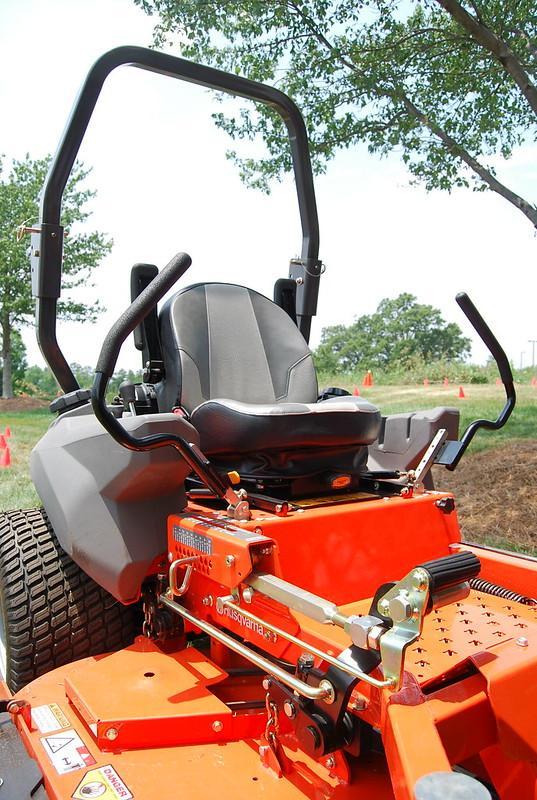
Zero-turn mowers are better suited for a lawn with many curves and obstacles.
Depending on the landscape, a zero-turn mower might be better for your property than a lawn tractor or vice versa.
For instance, a lawn tractor is the better choice if you have a sloppy or hilly lawn with no landscaping features or obstacles.
Let’s discuss it in detail!
Related: Starting A Lawn Mower That Has Been Sitting For Years | A Complete Guide
Lawn Tractors Are Better For Hilly Or Sloppy Lawns
Do you have a lot of slopes and hills in your yard? If this is the case, you will have a much easier time mowing your lawn if you use a tractor.
With lawn tractors, you can keep the mowing process moving along without any problems as they have the power to climb hills and slopes easily.
However, steeper than 15 degrees is still considered hazardous, and for your own protection, you should only use a standard push mower on extremely steep slopes.
So, if you have a very steep yard, you should always have a push mower as a backup.
Zero-Turn Mowers Are Best For Curvy Lawns
Since not every yard is going to be perfectly straight, certain types of mowers are going to have a difficult time navigating around curves in the yard. So, if your lawn has a lot of turns, you might want to get a zero-turn lawn mower.
If you have a zero-turn lawn mower, you can cut the grass very efficiently, even when there are turns and obstacles in the way.
Given their unique design, zero-turn mowers are the most efficient tool for navigating curved lawns. So, if you have a lawn mower like this one, it is much simpler to trim the grass while navigating tight corners.
Final Thoughts
It is completely up to the individual to decide which of these two options, a zero-turn mower or a lawn tractor, is superior. Your own preferences and the features of the land will determine which option is best suited to your property.
A zero-turn mower is ideal for areas with limited turning space. In comparison, the lawn tractor is best for working in more expansive locations.
So, which one is the most suitable for you? This will only depend on you!
Frequently Asked Questions
Does a zero-turn cut better than a lawn tractor?
While costing more than a riding mower, a zero-turn mower can quickly and effectively cut your lawn.
However, zero-turn mowers run with rear wheel drive and can be much more difficult to regulate on sloped lawns and in hilly areas of a yard.
What are the disadvantages of a zero-turn lawn mower?
The first disadvantage of a zero-turn mower is that it is difficult to mow on wet or muddy terrain because it is rear-wheel drive.
Additionally, while going over uneven ground or slopes steeper than 10 degrees, zero-turn mowers are prone to tipping over.
Furthermore, they are far more expensive and difficult to run.
Is a lawn tractor better than a lawn mower?
In general, lawn tractors are more powerful than riding lawn mowers and can cut up to 48 inches wide, which is substantially wider than a riding lawn mower but not as wide as a garden tractor.
Garden tractors are great tools for handling big tasks that could include more than merely mowing the lawn.
What size mower do I need for 1 acre?
If you have a lawn that is one acre in size, you should choose a lawn tractor with between 17 and 24 horsepower, or a zero-turn mower with between 20 and 25 horsepower.
Most mowers have a cutting height adjustment of one to five inches. And for most household users, a setting between one and four inches should be sufficient.
How many gallons of gas does it take to mow an acre?
Most household push mowers have a fuel capacity of no more than half a liter, and one tank will allow you to cut half an acre of grass.
Compared to homeowner mowers, commercial mowers use more gas per acre. For instance, larger riding mowers and mowers designed like tractors can use up to two to three gallons.
Editor’s Recommendations
Solved! How Long Do Fertilizers Take To Work? | Liquid Vs. Granular Fertilizer
Lawn Mowing Pattern & Techniques | Cut Your Grass Like A Pro
The Best Organic Fertilizers For Home Lawns For A Greener & Healthier Yard







